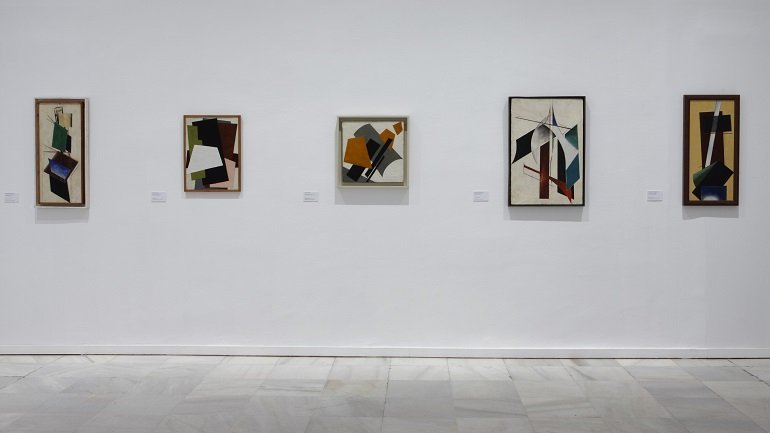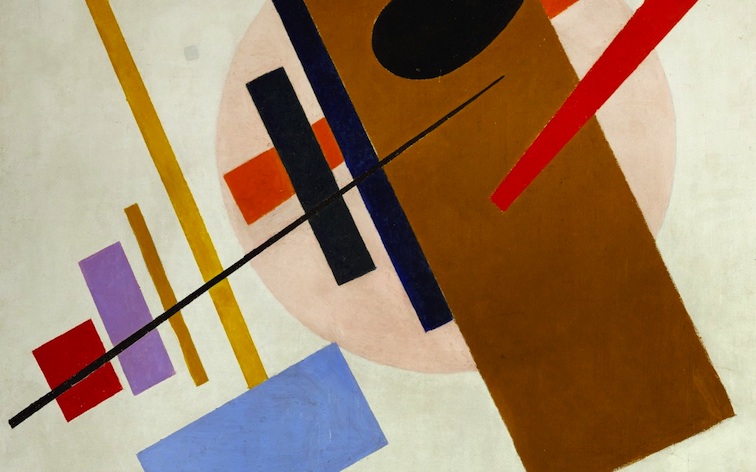In Russia, the language of geometric abstraction first appeared in 1915 in the work of the avant-garde artist Kazimir Malevich (1879–1935) (The Museum of Modern Art), in the style he termed Suprematism. Creating nonobjective compositions of elemental forms floating in white unstructured space, Malevich strove to achieve “the absolute,” the higher spiritual reality that he called the “fourth dimension.” Simultaneously, his compatriot Vladimir Tatlin (1885–1953) originated a new geometric abstract idiom in an innovative three-dimensional form, which he first dubbed “painterly reliefs” and subsequently “counter-reliefs” (1915–17). These were assemblages of randomly found industrial materials whose geometric form was dictated by their inherent properties, such as wood, metal, or glass. That principle, which Tatlin called “the culture of materials,” spurred the
...
Read more »
Views:
784
|
Added by:
editor
|
Date:
2016-05-10
|
|
 Exhibition view. Rodchenko and Popova: Defining Constructivism, 2009. Source Exhibition view. Rodchenko and Popova: Defining Constructivism, 2009. Source
Rodchenko’s abstract art from the period 1915–1920 is a permanent experiment with form, “inventing new discoveries.” The “root” idea of the artist was to destroy the material and clear existence of an object in the space of the canvas. And although “the forms still exist, fly, hover” in works of his “black period,” it is difficult to catch “what is the space, what kind of space it is, and what is the shape in it, and how this shape exists.” Texture in the painting swallows up all the elements – colour, light, volume and space. The artist wrote: “In the works there appears an ‘abstract quality of painting’
...
Read more »
Views:
846
|
Added by:
editor
|
Date:
2016-05-10
|
|
Views:
732
|
Added by:
editor
|
Date:
2016-05-10
|
|
 Kazimir Malevich, Supremus No. 55 1916. Source: Krasnodar Territorial Art Museum Kazimir Malevich, Supremus No. 55 1916. Source: Krasnodar Territorial Art Museum
Kazimir Malevich, an artist as influential as he was radical, cast a long shadow over the history of modern art. This, his first retrospective in thirty years and the first ever in the UK, unites works from collections in Russia, the US and Europe to tell a fascinating story of revolutionary ideals and the power of art itself...
His early experiments as a painter led him towards the invention of suprematism, a bold visual language of abstract geometric shapes and stark colours, epitomised by the Black Square. One of the defining works of Modernism, the painting was revealed to the world after months of secrecy and was hidden again for almost half a century after its creator’s death. It sits on a par with
...
Read more »
Views:
669
|
Added by:
editor
|
Date:
2016-05-10
|
|

Above: A section of Suprematist works by Kazimir Malevich exhibited for the first time at the 0.10 exhibition
By Andrew M. Goldstein
Aug. 16, 2014
Following the developments of Cubist and Futurist painting—in which the natural world was translated into a stark pictorial language of shapes, lines, and angles—Russia was one of the primary breeding grounds of pure abstraction, with Wassily Kandinsky doing much to popularize geometric art before gravitating to the gestural camp in later years. But it was Kazimir Malevich who today is often viewed as the forefather of geometric abstraction, beginning with his seminal 1915 paintings of black shapes—a circle, a square—on a white ground, and his legendary
...
Read more »
Views:
818
|
Added by:
editor
|
Date:
2016-05-10
|
| |
 Exhibition view. Rodchenko and Popova: Defining Constructivism, 2009.
Exhibition view. Rodchenko and Popova: Defining Constructivism, 2009.  Kazimir Malevich, Supremus No. 55 1916. Source:
Kazimir Malevich, Supremus No. 55 1916. Source: 

